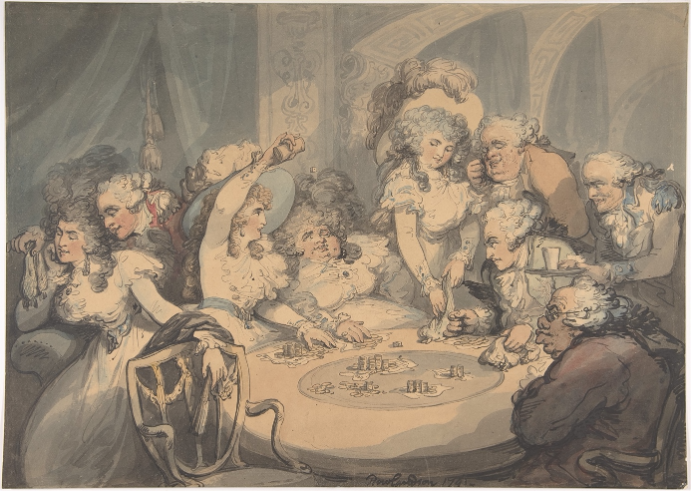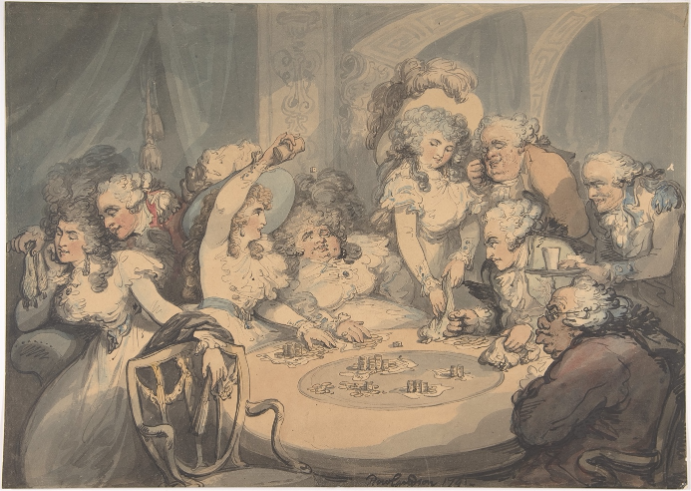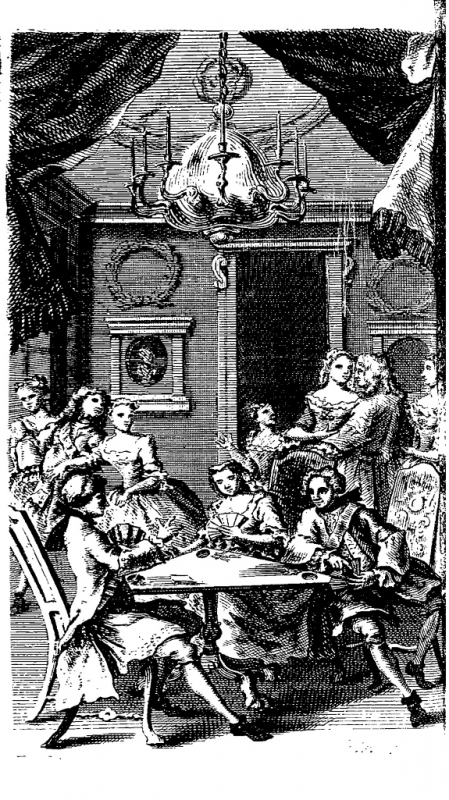Résumé
Although game scene paintings from the sixteenth century usually feature players gathered around plain everyday tables in dark taverns, gaming tables evolved into fashionable objects especially designed for domestic spaces at the end of the seventeenth century, testifying to the growing popularity of gaming. This evolution, which was in large part due to the technical progress of marquetry, also turned the gaming table into the symbol of the dissolute life of players whose addiction got the better of them, the very image of a corrupted sociability in which each participant is a prey in the eye of the rapacious gamester.
Mots-clés
Playing games was a crucial aspect of daily sociability especially among the aristocracy and the middle classes in the long eighteenth century as we can see from the numerous treatises and publications on the subject such as Edmund Hoyle’s The Polite Gamester (1745) or Games improved (1755) in which card games and table games in particular took pride of place. Consequently, the gaming table itself became a desirable piece of furniture.1 The first references to tables purposely built for playing games date back to the late seventeenth century. They testify to the growing trend of specialised furniture-making following the changes in the organisation of domestic space which was by then centred on smaller rooms that had a permanently designated function. Indeed, the demand for private gaming tables increased throughout the eighteenth century and led to changes in design allowing these pieces of furniture to be smaller than the gaming tables used in clubs – such as those immortalised in drawings and caricatures of White’s for instance – as well as highly adaptable.2
- 1. For an analysis on how card games gradually became a mark of hospitality favouring social interactions among the middle classes see Janet E. Mullin, ‘“We Had Carding”: Hospitable Card Play and Polite Domestic Sociability among the Middling Sort in Eighteenth-Century England’, Journal of Social History (vol. 43, n° 4, Summer 2009), p. 989-1008.
- 2. On the general history of gaming tables in France and Europe see Pierre Kjellberg, Le Mobilier français et européen du Moyen Âge à nos jours (Paris : Les Éditions de l’Armateur, 2011), p. 237-238.
Very often, these tables in fact served several purposes as they were comprised of multiple surfaces, which were adapted to different games, most commonly these would include backgammon, cards and chess. The surface dedicated to card games was usually covered in green baize3 to create a contrast between the table and cards and to prevent cards from sliding too quickly on the surface. Tables also offered practical slots, or even hidden drawers and compartments, in which players could safely store their cards or money during the game. Many of the tables we can still see today can also be folded and turned into small console tables which could be placed against a wall to avoid occupying too much space when not in use. At the end of the eighteenth century, it appears that owning the right type of table was a prerequisite to play certain games: in a 1793 treatise on Faro and Rouge et Noir for instance the author, French exile and mathematician Abraham De Moivre, details what type of table should be used and how for each of these games.4
Aesthetic and Technical Aspects
As a table chiefly designed to entertain (in every sense of the word), it was also endowed with a representative function, which may account for its marked decorative dimension. Although many tables remained relatively simple in spite of their specialised function, more and more luxury gaming tables were made available throughout the eighteenth century. The technical improvements of marquetry allowed craftsmen to create varying patterns of colour alternating different types of woods imported from all over the world and contrasting with the previous years’ extensive use of walnut wood. Mahogany in particular became fashionable in England at the beginning of the eighteenth century. The tables could be of rectangular or triangular shape and most of them usually seated three to four players, creating a strong sense of intimacy if compared with wider dining tables for instance.
In England, gaming tables became objects of luxury strongly inspired by the different continental trends, like those initiated by the Boulle workshop in Paris under the reign of Louis XV. In addition to importations, French taste and technique were also introduced in England by the huguenots craftsmen and cabinet-makers like Pierre Langlois who had emigrated from France, especially after the Revocation of the Edit de Nantes in 1685. These aesthetic influences on furniture can be seen in Thomas Chippendale’s famous pattern book The Gentleman and Cabinet-Maker’s Director, published in 1754. They were often merged with more characteristically English decorative traits such as the ‘pad foot’ (a type of rounded foot), often seen at the end of the legs of English gaming tables. These were sometimes sculpted in the form of a paw as can be seen in the frontispiece of the 1734 edition of The Compleat Gamester. Although this element was a common decorative element of the naturalistic ornamentation of the time, it is also strongly evocative of the animalisation frequently associated with gaming. In an anonymous 1761 treatise on gaming the author concludes that:
‘Gaming’s a fiend with Harpy Claws and Eyes,
Of Paper Substance, but prodigious Size:
Which like Eve’s Serpent wears seducing Smiles,
And when it proffers most, the most beguiles:
The sight of Gold its Appetite creates,
And dread Destruction on its Meal awaits’5
- 5. Anon., An Essay on Gaming in An Epistle to a Young Nobleman (London, 1761), p. 19.
The gaming table was, it seems, also seen as a place of danger, where unsuspecting players could be cheated out of their fortune in just a few hours.
Symbolical Dimension
Culturally, the gaming table was an essentially ambivalent piece of furniture. The smaller tables’ dimensions were designed to create a feeling of intimacy and proximity between players in a domestic environment in a way that would facilitate conversation. The ornamentations of the table denoted a form of refinement. However, this proximity could sometimes be deceitful and the gaming table was also strongly associated with risk and debt. Eighteenth-century prescriptive literature abounds with stories of rich aristocrats whose excesses at the gaming table led them to ruin.6 In these narratives, the gaming table becomes a threat to the very fabric of society, something which is suggested in several satirical drawings by Thomas Rowlandson, who may himself have had ‘an uncontrollable passion for gaming’ according to his obituarist.7 In A Gaming Table at Devonshire House (1791) for instance, the artist portrays Georgiana, Duchess of Devonshire, whose debt amounted to more than £ 60,000 by 1789, at a game of Faro with her guests, who seem mesmerized by the dice that are about to fall. The characters’ fascination with what is happening at the gaming table blinds them to the scene taking place behind them, in which an officer seems to be seducing a woman, or perhaps offering her more money to bet on the game. It is also unclear whether the woman at the centre of this piece is sleeping or pretending to sleep to deceive her opponents.

The concern for an excessive amount of time spent at the gaming table was especially levelled at the aristocracy and the upper classes as this leisure activity was seen as a form of moral decadence. Gaming was in fact often opposed to the heroic military feats of an idealised past. This contrast between the battlefield and the gaming table was also hinted at in literary works of the time. The green baize – which, as we have seen, was initially designed to evoke the lawn on which billiards was played – led Alexander Pope to liken it to a green battlefield during the game of Ombre between Belinda and the Baron in The Rape of the Lock (1714): ‘As many more Manillio forc’d to yield,/And march'd a Victor from the verdant Field’ (Canto III). Pope’s mock-heroic metaphor takes on a more provocative aspect when it is taken up, much later, by William Makepeace Thackeray’s famous fictional professional gambler Barry Lyndon (1844). As he chooses his new path in life, the narrator claims the baize of the card table is tantamount to the battlefields where aristocrats vied for honours and chivalric deeds:
‘You call a doctor an honourable man, a swindling quack, who does not believe in the nostrums which he prescribes, and takes your guinea for whispering in your ear that it is a fine morning; and yet, forsooth, a gallant man who sits him down before the baize and challenges all comers, his money against theirs, his fortune against theirs, is proscribed by your modern moral world. It is a conspiracy of the middle classes against gentlemen: it is only the shopkeeper cant which is to go down nowadays. I say that play was an institution of chivalry: it has been wrecked, along with other privileges of men of birth. When Seingalt engaged a man for six-and-thirty hours without leaving the table, do you think he showed no courage? […] Is THIS not something like boldness?’8
- 8. William Makepeace Thackeray, Barry Lyndon, ed. Andrew Sanders (Oxford: Oxford University Press, 2008), p. 129-130.
By the ninteenth century, the gaming table had become a metonymy for the decadent gambling spirit the eighteenth century was so frequently associated with.
Partager
Références complémentaires
Andrew, Donna T., Aristocratic Vice: The Attack on Duelling, Suicide, Adultery, and Gambling in Eighteenth-Century England (New Haven & London: Yale University Press, 2012).
Kjellberg, Pierre, Le Mobilier français et européen du Moyen Âge à nos jours (Paris: Les Éditions de l’Amateur, 2011).
Ramond, Pierre, Chefs d’œuvre de marqueteurs, t. 2 : de la Régence à nos jours (Dourdan : Éditions H. Vial, 1996).
Ramond, Pierre, La Marqueterie (Dourdan : Éditions H. Vial, 1988).
Reith, Gerda, The Age of Chance: Gambling in Western Culture (London: Routledge, 1999).

